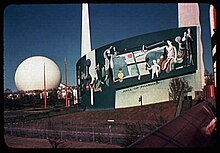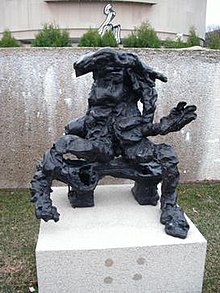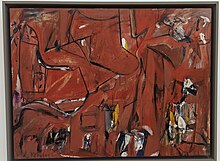Contents
Willem de Kooning (/də ˈkuːnɪŋ/;[2] Dutch: [ˈʋɪləm də ˈkoːnɪŋ]; April 24, 1904 – March 19, 1997) was a Dutch-American abstract expressionist artist. Born in Rotterdam, in the Netherlands, he moved to the United States in 1926, becoming an American citizen in 1962.[3] In 1943, he married painter Elaine Fried.
In the years after World War II, de Kooning painted in a style that came to be referred to as abstract expressionism or "action painting", and was part of a group of artists that came to be known as the New York School. Other painters in this group included Jackson Pollock, Elaine de Kooning, Lee Krasner, Franz Kline, Arshile Gorky, Mark Rothko, Hans Hofmann, John Ferren, Nell Blaine, Adolph Gottlieb, Anne Ryan, Robert Motherwell, Philip Guston, Clyfford Still, and Richard Pousette-Dart. De Kooning's retrospective held at MoMA in 2011–2012 made him one of the best-known artists of the 20th century.[4]
Biography

Willem de Kooning was born in Rotterdam, the Netherlands, on April 24, 1904. His parents, Leendert de Kooning and Cornelia Nobel, were divorced in 1907, and de Kooning lived first with his father and then with his mother. He left school in 1916 and became an apprentice in a firm of commercial artists. Until 1924 he attended evening classes in Rotterdam at the Academie van Beeldende Kunsten en Technische Wetenschappen (Academy of Fine Arts and Applied Sciences), now the Willem de Kooning Academie.[3] In 1926, de Kooning traveled to the United States as a stowaway on the Shelley, a British freighter bound for Argentina, and on August 15 landed at Newport News, Virginia. He intended to become an illustrator of pulp magazines; he recalled in 1969 that "those American illustrators were the most inspiring artists to me!"[5] He stayed at the Dutch Seamen's Home in Hoboken, New Jersey, and found work as a house painter. In 1927, he moved to Manhattan, where he had a studio on West Forty-fourth Street. He supported himself with jobs in carpentry, house painting and commercial art.[3]
De Kooning began painting in his free time, and in 1928 he joined the art colony at Woodstock, New York. He also began to meet some of the modernist artists active in Manhattan. Among them were the American Stuart Davis, the Armenian Arshile Gorky and the Russian John Graham, whom de Kooning collectively called the "Three Musketeers".[6]: 98 Gorky, whom de Kooning first met at the home of Misha Reznikoff, became a close friend and, for at least ten years, an important influence.[6]: 100 Balcomb Greene said that "de Kooning virtually worshipped Gorky"; according to Aristodimos Kaldis, "Gorky was de Kooning's master".[6]: 184 De Kooning's drawing Self-portrait with Imaginary Brother, from about 1938, may show him with Gorky; the pose of the figures is that of a photograph of Gorky with Peter Busa in about 1936.[6]: 184

De Kooning joined the Artists Union in 1934, and in 1935 was employed in the Federal Art Project of the Works Progress Administration, for which he designed a number of murals including some for the Williamsburg Federal Housing Project in Brooklyn. None of them were executed,[1] but a sketch for one was included in New Horizons in American Art at the Museum of Modern Art, his first group show. Starting in 1937, when De Kooning had to leave the Federal Art Project because he did not have American citizenship, he began to work full-time as an artist, earning income from commissions and by giving lessons.[3] That year de Kooning was assigned to a portion of the mural Medicine for the Hall of Pharmacy at the 1939 World's Fair in New York, which drew the attention of critics, the images themselves so completely new and distinct from the era of American realism.
De Kooning met his wife, Elaine Fried, at the American Artists School in New York. She was 14 years his junior. Thus was to begin a lifelong partnership affected by alcoholism, lack of money, love affairs, quarrels and separations. They were married on December 9, 1943. De Kooning worked on his first series of portrait paintings: standing or sedentary men like Two Men Standing, Man, and Seated Figure (Classic Male), even combining with self-portraits as with Portrait with Imaginary Brother (1938–39). At this time, de Kooning's work borrowed strongly from Gorky's surrealist imagery and was influenced by Picasso. This changed only when de Kooning met the younger painter Franz Kline, who was also working with the figurative style of American realism and had been drawn to monochrome. Kline, who died young, was one of de Kooning's closest artist friends. Kline's influence is evident in de Kooning's calligraphic black images of this period.
During the late 1940s and early '50s, de Kooning joined other fellow contemporary artists including Jackson Pollock and Franz Kline, in their struggle to break free from common artistic movements of the era including Cubism, Surrealism and Regionalism. Their emotive gestures and abstract pieces were a result of their attempt to abandon the other movements. This movement was later called "Abstract Expressionism" sometimes known as "Action Painting" and the "New York School".[7]
Between 1948 and 1953, de Kooning became more well known for his artistic techniques but he tried not to repeat himself.

In the late 1950s, de Kooning's work shifted away from the figurative work of the women (though he would return to that subject matter on occasion) and began to display an interest in more abstract, less representational imagery.[8]: 56 He became a US citizen on March 13, 1962, and in the following year moved from Broadway to a small house in East Hampton, a house which Elaine's brother Peter Fried had sold to him two years before. He built a studio near by, and lived in the house to the end of his life.[3][9]
It was revealed that, toward the end of his life, de Kooning had begun to lose his memory in the late 1980s and had been suffering from Alzheimer's disease for some time.[9] This revelation has initiated considerable debate among scholars and critics about how responsible de Kooning was for the creation of his late work.[10]
Succumbing to the progression of his disease, de Kooning painted his final works in 1991. He died in 1997 at the age of 92[11] and was cremated.[12]
Marriage to Elaine de Kooning
Elaine had admired Willem's artwork before meeting him; in 1938 her teacher introduced her to de Kooning at a Manhattan cafeteria when she was 20 and he 34. After meeting, he began to instruct her in drawing and painting. They painted in Willem's loft at 143 West 21st Street, and he was known for his harsh criticism of her work, "sternly requiring that she draw and redraw a figure or still life and insisting on fine, accurate, clear linear definition supported by precisely modulated shading."[13] He even destroyed many of her drawings, but this "impelled Elaine to strive for both precision and grace in her work".[13] When they married in 1943, she moved into his loft and they continued sharing studio spaces.[13]
Elaine and Willem de Kooning had what was later called an open marriage; they both were casual about sex and about each other's affairs. Elaine had affairs with men who helped further Willem's career, such as Harold Rosenberg, who was a renowned art critic, Thomas B. Hess, who was a writer about art and managing editor for ARTnews, and Charles Egan, owner of the Charles Egan Gallery.
Willem had a daughter, Lisa de Kooning, in 1956, as a result of his affair with Joan Ward.[13] He also had a romance with Ruth Kligman after her affair with Jackson Pollock ended with his death in a car crash in 1956.[14]
Elaine and Willem both struggled with alcoholism, which eventually led to their separation in 1957.[13] While separated, Elaine remained in New York, struggling with poverty, and Willem moved to Long Island and dealt with depression. Despite bouts with alcoholism, they both continued painting. Although separated for nearly twenty years, they never divorced, and ultimately reunited in 1976.[13]
Work
Early work
De Kooning's paintings of the 1930s and early 1940s are abstract still-lifes characterised by geometric or biomorphic shapes and strong colours. They show the influence of his friends Davis, Gorky and Graham, but also of Arp, Joan Miró, Mondrian and Pablo Picasso.[1] In the same years, de Kooning also painted a series of solitary male figures, either standing or seated, against undefined backgrounds; many of these are unfinished.[1][3]
Black-and-white abstracts
By 1946, de Kooning had begun a series of black-and-white paintings, which he would continue into 1949. During this period he had his first one-man show at the Charles Egan Gallery in 1948 consisting largely of black-and-white works, although a few pieces have passages of bright color. De Kooning's black paintings are important to the history of abstract expressionism owing to their densely impacted forms, their mixed media, and their technique.[8]: 25

The Woman series

De Kooning painted women regularly in the early and late 1940s, but it was not until 1950 that he began to explore the female subject exclusively. His well-known Woman series, begun in 1950 and culminating in Woman VI, owes much to Picasso, not least in the aggressive, penetrative breaking apart of the figure, and the spaces around it. Picasso's late works show signs that he, in turn, saw images of works by Pollock and de Kooning.[15]: 17 De Kooning led the 1950s art world into a new movement known as American abstract expressionism. "From 1940 to the present, Woman has manifested herself in de Kooning's paintings and drawings as at once the focus of desire, frustration, inner conflict, pleasure, … and as posing problems of conception and handling as demanding as those of an engineer."[16] The female figure is an important symbol for de Kooning's art career and his own life. The Woman painting is considered as a significant work of art for the museum through its historical context about the post-World War II history and American feminist movement. Additionally, the medium (oil, enamel, and charcoal on canvas) of this painting makes it different from others of de Kooning's time.
Notable works
The painter is noted for his paintings: Woman III (1953), Woman VI (1953), Interchange (1955), and Police Gazette (1955). Some notable sculptures are Clamdigger (1972/1976) and Seated Woman on a Bench (1972/1976).


Market reception
Some of de Kooning's paintings have been sold in the 21st century for record prices. In November 2006, the American business magnate David Geffen sold his oil painting Woman III to hedge fund manager Steven A. Cohen for $137.5 million, just below the record at the time of $140 million, which involved the same people in the same month for Jackson Pollock's No. 5, 1948.[17] A month earlier Cohen had already paid Geffen $63.5 million for Police Gazette by de Kooning.[18] In September 2015, Geffen sold de Kooning's oil painting Interchange to hedge-fund billionaire Ken Griffin for ca. $300 million, the highest price paid for a painting at the time.[19] It held the record until November 15, 2017, when the da Vinci Salvator Mundi sold for $450 million at Christie's in New York.[20] In November 2016, Untitled XXV sold for $66.3 million at Christie's in New York. This was a record price for a de Kooning piece sold at public auction.[21]
According to Patricia Failing:
- By the end of the 1950s, in the opinion of many, the most influential painter at work for the world was the abstract expressionist master William de Kooning. Although it was 1948 before he was given his first one man show, de Kooning had previously acquired a formidable underground reputation which served to boost him to prominence, along with Jackson Pollock, as a leading exponent of "action painting."[22]
Solo exhibitions
The artist was featured in a number of solo exhibitions from 1948 to 1966, many in New York but also nationally and internationally. Specifically, he had 14 separate exhibitions, with two exhibitions per annum in the years 1953, 1964, and 1965. He was featured at the Egan Gallery, the Sidney Janis Gallery, the Museum of Fine Arts, Boston, the Arts Club of Chicago, the Martha Jackson Gallery, the Workshop Center, the Paul Kantor Gallery, the Hames Goodman Gallery, the Allan Stone Gallery, and the Smith College Museum of Art. Most of the exhibitions lasted for three weeks to one month.[8]: 126 Most recent exhibition, De Kooning: Five Decades, took place in the Mnuchin Gallery, New York City, from April 19 till June 15, 2019.[23]
See also
- Abstract expressionism
- Action painting
- American Figurative Expressionism
- New York Figurative Expressionism
- Elaine de Kooning
- Impasto
- Women in art
- Erased de Kooning Drawing
References
- ^ a b c d Christoph Grunenberg, et al. (2011). De Kooning: (1) Willem de Kooning. Grove Art Online. Oxford Art Online. Oxford: Oxford University Press. Accessed February 2015. (subscription required)
- ^ "de Kooning". The Collins English Dictionary, online edition. London: HarperCollins Publishers.
- ^ a b c d e f Tracy Schpero Fitzpatrick (2001). de Kooning, Willem. American National Biography Online, January 2001 update. Accessed February 2015. (subscription required)
- ^ McGlynn, Tom (June 5, 2019). "De Kooning: Five Decades". The Brooklyn Rail. Retrieved February 25, 2020.
- ^ Saunders, David (Summer 2005). "The Art and Social Conditions of John Walter Scott". Illustration (14): 5–35.
- ^ a b c d Matthew Spender (1999). From a High Place: a Life of Arshile Gorky. New York: Knopf. ISBN 978-0-375-40378-1.
- ^ "The Artists". The Willem de Kooning Foundation. Retrieved January 2, 2021.
- ^ a b c Harry F. Gaugh (1983). Willem de Kooning. New York: Abbeville Press. ISBN 978-0-89659-332-9.
- ^ a b "Willem de Kooning Biography, Art, and Analysis of Works". The Art Story. Retrieved April 2, 2017.
- ^ Swinnen, Aafje, and Mark Schweda. 2015. Popularizing Dementia: Public Expressions and Representations of Forgetfulness. Bielefeld: Transcript. p. 150. ISBN 978-3-8376-2710-7.
- ^ Stevens, Mark; Swan, Annalyn (2004). de Kooning: An American Master. Knopf. p. 629.
- ^ Stevens, Mark; Swan, Annalyn (2004). de Kooning: An American Master. Knopf. p. 689.
- ^ a b c d e f Hall, Lee. Elaine and Bill: Portrait of a Marriage.
- ^ (registration required) Kennedy, Randy (March 6, 2010). "Ruth Kligman, Muse and Artist, Dies at 80". The New York Times.
- ^ Terry Smith (2011). Contemporary art: world currents. Upper Saddle River, [NJ]: Prentice Hall. ISBN 978-0-205-03440-6.
- ^ Willem de Kooning. Text by Harold Rosenberg. 29.
- ^ Vogel, Carol (November 18, 2006). "Landmark De Kooning Crowns Collection". The New York Times.
- ^ Vogel, Carol (October 12, 2006). "Works by Johns and de Kooning Sell for $143.5 Million". The New York Times.
- ^ "Billionaire drops $500M for 2 masterpieces," February 19, 2016, Bloomberg News, as republished by Fox News, at [1].
- ^ Crow, Kelly (November 16, 2017). "Leonardo da Vinci Painting 'Salvator Mundi' Sells for $450.3 Million". Wall Street Journal. ISSN 0099-9660. Retrieved November 16, 2017.
- ^ Duray, Dan (November 16, 2016). "De Kooning painting sells for record $66m at Christie's New York". The Art Newspaper. Archived from the original on December 1, 2016. Retrieved November 30, 2016.
- ^ John A. Garraty, ed., Encyclopedia of American Biography, 1974, pp. 269–270.
- ^ "April 19 – June 15, 2019 – Five Decades – De Kooning – Exhibitions – Mnuchin Gallery". www.mnuchingallery.com. Retrieved February 25, 2020.
Further reading
- Marika Herskovic, American Abstract and Figurative Expressionism Style Is Timely Art Is Timeless An Illustrated Survey With Artists' Statements, Artwork and Biographies. (New York School Press, 2009). ISBN 978-0-9677994-2-1. pp. 76–79; p. 127; p. 136.
- Marika Herskovic, American Abstract Expressionism of the 1950s: An Illustrated Survey, (New York School Press, 2003). ISBN 0-9677994-1-4. pp. 94–97.
- Marika Herskovic, New York School Abstract Expressionists: Artists Choice by Artists, (New York School Press, 2000). ISBN 0-9677994-0-6. p. 16; p. 36; p. 106–109.
- Mark Stevens and Annalyn Swan, "de Kooning: An American Master", 2004, Knopf, Borzoi Books ISBN 1-4000-4175-9
- Hall, Lee (1993). Elaine and Bill, Portrait of a Marriage: The Lives of Willem and Elaine de Kooning. New York City, NY: HarperCollins Publishing. ISBN 9780060183059.
- Edvard Lieber, Willem de Kooning: Reflections in the Studio, 2000, Harry N. Abrams, Inc. ISBN 0-8109-4560-6
- ART USA NOW Ed. Lee Nordness; Vol.1, (Viking Press, 1963.) pp. 134–137.
- Richard Shiff, On "Between Sense and de Kooning", The Montréal Review, September 2011.
- Judith Zilczer, "Willem de Kooning." Phaidon Press, 2017. ISBN 978-0-7148-7316-9
External links
- Willem de Kooning Foundation
- Willem de Kooning at the Museum of Modern Art
- Links to reproductions
- Willem de Kooning at Xavier Hufkens, Brussels
- Woman in the Pool (1969) Phoenix Art Museum
- de Kooning's work in the Guggenheim Collection
- Willem de Kooning in the National Gallery of Australia's Kenneth Tyler collection
- Sam Hunter, "Willem de Kooning Lecture", The Baltimore Museum of Art: Baltimore, Maryland, 1964 Retrieved June 26, 2012
- Frank O'Hara — Rainbow Warrior
- A small-town couple left behind a stolen painting worth over $100 million — and a big mystery, Washington Post
- The American Presidency Project
- Lifetime Honors – National Medal of Arts

